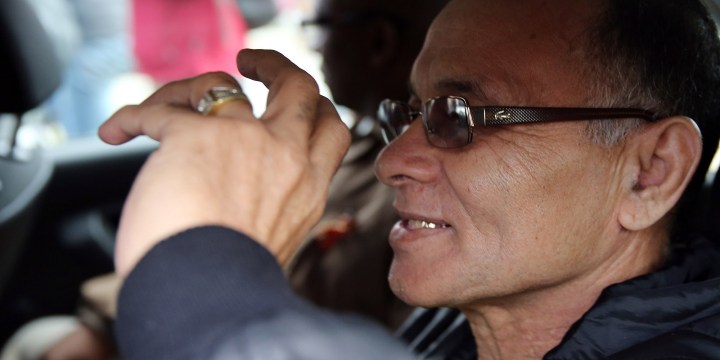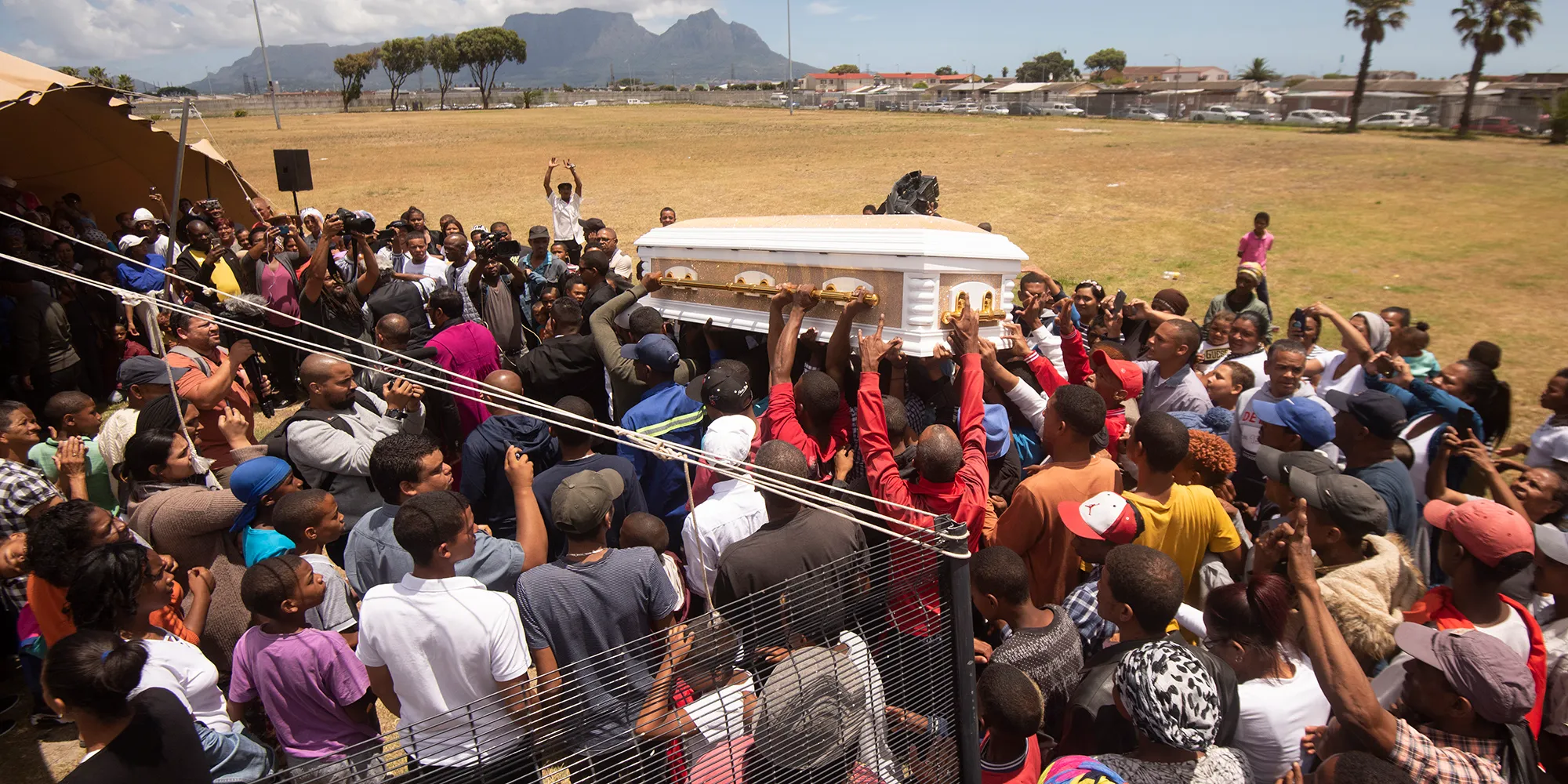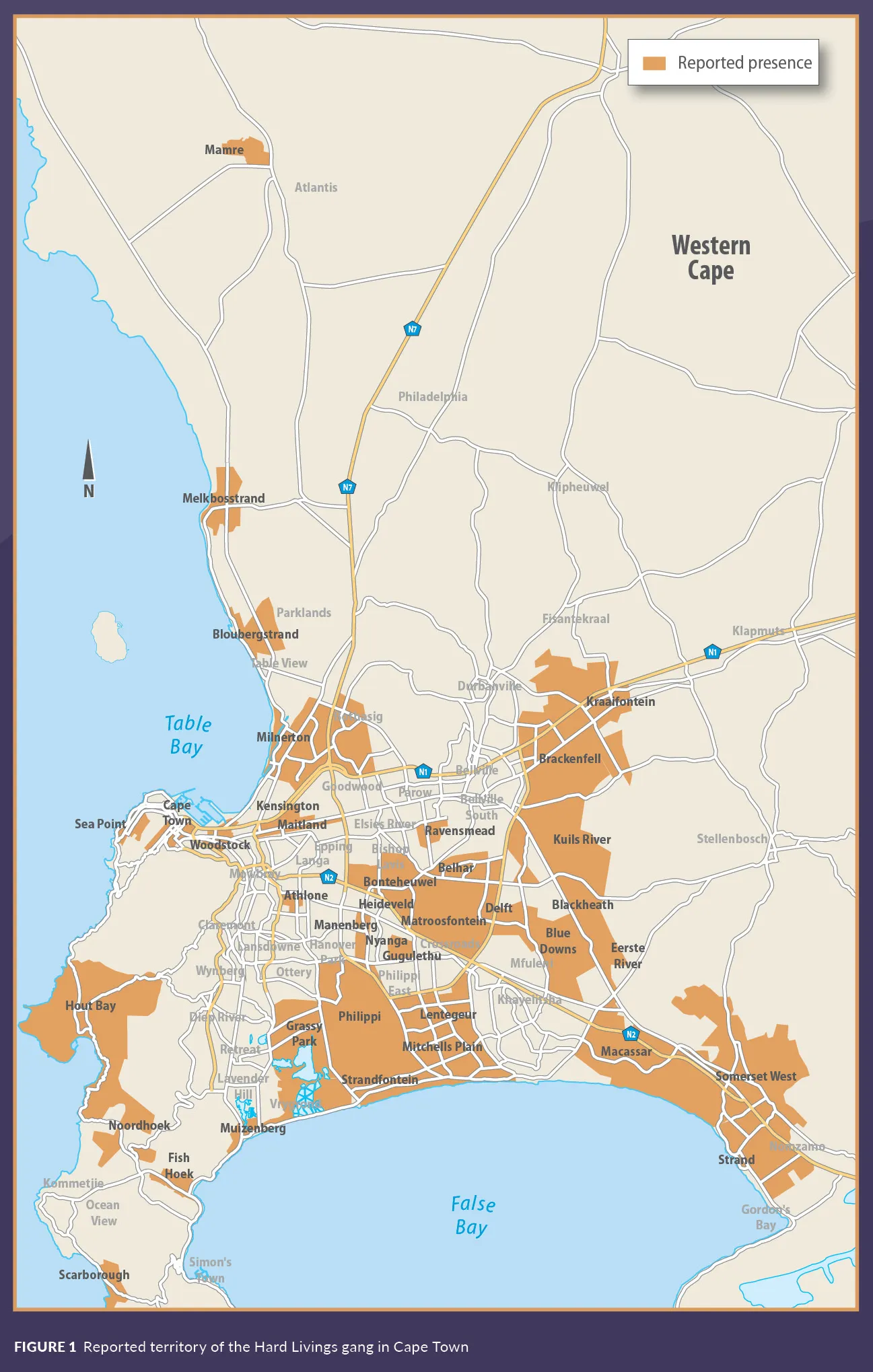HARD LIVINGS
Who killed Rashied Staggie? Assassination theories abound as uneasy peace follows gang boss’s murder

When the infamous gang boss Rashied Staggie was gunned down outside his home in the Cape Town suburb of Salt River in December, some predicted a bloodbath. The Staggie brothers were the founders and leaders of one of Cape Town’s largest and most violent gangs, the Hard Livings.
This article first appeared in the Global Initiative Against Transnational Organised Crime’s monthly Eastern and Southern Africa Risk Bulletin. The Global Initiative is a network of more than 500 experts on organised crime drawn from law enforcement, academia, conservation, technology, media, the private sector and development agencies. It publishes research and analysis on emerging criminal threats and works to develop innovative strategies to counter organised crime globally.
Immediately after Rashied Staggie’s death – on the same street where his twin brother, Rashaad Staggie, had been murdered 23 years earlier – the Cape Flats and social media came alive with various theories on who was behind the murder, and potential doomsday scenarios of how the situation would unfold.

Friends and family celebrate the life of South African gangster and leader of Hard Living gang Rashied Staggie on December 21, 2019, in Cape Town, South Africa. Rashied Staggie was shot and killed in Salt River on December 13th, 2019. (Photo by Gallo Images/Brenton Geach)
Yet the citywide gang warfare some predicted has not yet come about. Staggie’s death has, in fact, been welcomed across the Cape Flats by gangs and the community. His perceived attempts to live a double life – by claiming to have converted to Christianity while in fact continuing his criminal activities – had instilled anger in opposing gangs. Three months on, the situation in the Cape Flats communities still feels precarious, but Staggie’s death seems to have returned some fleeting order.
The motives for Staggie’s murder
Research into the Cape Flats gang landscape conducted by the Global Initiative Against Transnational Organised Crime, including 10 interviews with community leaders, activists, gang members, and gang leaders, all with intimate knowledge of the case – unearthed three possible motives, sometimes overlapping, for Staggie’s death. These involve:
- A relative of Staggie’s upset at not being promoted within the ranks of the Hard Livings;
- Staggie’s deteriorating relationship with the 28s gang; and
- His alleged defrauding of Nigerians seeking entry into the Cape Town drug market.
In the lives of high-profile criminal figures who are surrounded by mystery and legends, it is often difficult to separate truth from fiction. Whatever the immediate motive for Staggie’s killing, it is clear that his criminal business interests and his relationships were deteriorating before his death.
The first theory (which came up in every interview) involves a relative of Staggie’s, who aspired to rise up the ranks of the Hard Livings. Those aspirations were ultimately frustrated and it is claimed that he plotted with a rival gang to arrange the hit.
The second theory relates to the failing relationship between Staggie and the 28s gang. Years before, the Staggie brothers had worked closely with the 28s under the Firm and CORE, two alliances of gang leaders. The Firm focused more on regulating the drug trade, while CORE’s aim was ostensibly to contribute to community development in partnership with the government. The strength of this relationship apparently largely rested on Rashaad Staggie’s good standing with the 28s. However, Staggie’s relations with the 28s eventually deteriorated, and rumours link him to multiple recent gang hits or attempted hits.
The third theory relates to allegations that Staggie defrauded foreign nationals. Because of his reputation as a prominent and well-connected figure in the drug trade, Staggie was apparently approached by Nigerians trying to invest in Cape Town’s drug industry. Staggie is said to have taken their money but failed to deliver on his promise to invest the money in the drug trade for them, keeping it for himself instead.
Staggie’s double life and rivalries
Amid the conflicting narratives around Staggie’s death, what emerged clearly was that a variety of interests in the Cape Town underworld were pleased with the outcome: not only those mentioned above, who might have been directly implicated in the killing, but gang and community leaders from all over the Cape Flats expressed their approval. It was said that people had become frustrated with what was termed his double life. While Staggie had supposedly left gang life behind and converted to Christianity, in fact, he was more active than ever in various criminal markets across Cape Town.
Staggie’s “double life” dates back to his spell in prison following his conviction for the gang-rape of a 17-year-old girl in 2003. This attack was reportedly in revenge for her informing on the gang and revealing where firearms were stashed. She was also shot in an apparent hit attempt years later and still lives in hiding. Before Staggie’s release from prison for good behaviour in 2013, he supposedly changed his life and converted to Christianity. He claimed to no longer be a gang boss or involved in the drug trade in any way, but to have refocused on giving back to the community which he admitted having wronged. But behind this public persona, he is said to have continued his business as usual.
Very few people believed that his conversion was genuine, and his new image upset many in the community. Most of all, it was problematic for rival gangs. Staggie’s business was in fact growing while he profited from his new low profile, and the gangs weren’t happy about it. As one gang leader said, “Lots of people wanted him dead, and this goes back to his previous relationships with other gangs, but also because he wanted control of the whole city.”
As one of Cape Town’s religious leaders put it, “The gangs allowed Staggie to live as a civilian. They gave him leeway to a certain extent, but when he tried to operate in both domains, his death was inevitable. There is only one way to exit the gang life, and that is up through the porthole to God.” This means that the gangs will accept it if members leave for genuine religious conviction and actually change their lives, but they will not tolerate someone living a double life. “Gangs don’t allow you to block the porthole.”
Earlier Global Initiative research also suggested that Staggie was profiting from stirring up gang rivalry in the western areas of Johannesburg and supplying drugs to the two main opposing gangs in the area. Competition between the two groups is said to have benefited Staggie, who allegedly also supplied Cape hitmen to both factions, apparently to ensure that no individual achieved complete dominance in the area. At the same time, local church and business groups are said to have been implicated in the ongoing drug trade through the laundering of drug profits, suggesting that Staggie’s religious connections also turned out to be directly lucrative for his drug business.
Staggie was also facing dissent from within the ranks of the Hard Livings. Although the Hard Livings have managed to establish themselves over the past three decades as a strong and well-managed gang, in recent years infighting, power struggles, shifting alliances and Staggie’s reputedly inauthentic exit from the gang life resulted in instability, ultimately leading to his death.
The aftermath
The immediate aftermath of Staggie’s death was significantly quieter than expected. Although gang violence continued, it did not increase. As of this writing, three months after his death, communities are still cautious and slightly unsettled. They are expecting something, although they are not sure what. One community leader said that, “People thought that there was going to be backlash after Staggie’s death, but there wasn’t and there won’t be. It was quiet after his death because his death was predetermined by the gangs. That’s how the gangs wanted it.”
Time will tell whether this peaceable outcome will endure. Interviews with Hard Livings gang members and leaders revealed a definite division within the gang’s ranks, and they expect more infighting in the future. Some also predicted that the Americans (another Cape Town gang) would make use of this transition period to gain back power. One source said they were stocking up on firearms for this purpose so that “the Hard Livings can see them again”, meaning that the increased firepower would help them be noticed and feared. Another interviewee mentioned that the Hard Livings were going to hold Staggie’s implicated relative accountable.
When asked what that meant, the response was that “he must watch himself”.
To date, there have been no publicly reported arrests for the murder (some interviewees suggested that arrests had been made but that the police were not disclosing this). What is clear is that Staggie’s desire to dabble in multiple markets and with multiple players, while claiming to live a crime-free life, ultimately led to his death. Only time will tell what the long-term impact will be on the Hard Livings’ strength, structure and alliances; perhaps over time it will also become clearer who ultimately ordered the hit.
Who are the Hard Livings?
The Hard Livings have the third-biggest territory of any gang in Cape Town, after the Americans and the 28s. Our research on Cape Town’s gangs found that the Hard Livings are present in 35 neighbourhoods throughout the city, although their origins and stronghold are in Manenberg. The map below shows the Hard Livings’ territory, which stretches across the city of Cape Town from Strand to Kraaifontein and Sea Point. Although they have a significant geographic presence, they are still far less widespread than their biggest rivals, the Americans, who are present in 73 areas, covering most of the city.

The Hard Livings have the fourth-biggest gang membership (following the Americans, 28s, and Terrible Josters, respectively) with an estimated total of 6,040 members, mostly concentrated in Manenberg, Mitchells Plain and Delft.
Although the Hard Livings are smaller than the Americans in terms of turf and membership, they are far more centralised, hierarchical and organised. The Americans, by contrast, have multiple leaders operating in different areas. According to interviewees, the Hard Livings have secured large drug and firearm shipments that smaller or more fragmented gangs have been unable to achieve.
Other than dealing in drugs and firearms, the Hard Livings’ operations also include protection rackets, extortion, prostitution, and the taxi business, though drugs remain the most important business. To keep their strength and business connections, gangs need to form alliances with other gangs; such alliances change frequently. The Hard Livings are currently allied with several other Cape Town gangs, including the Laughing Boys, Ghettos, Jesters, Junky Funky Kids, and Mongrels. The Hard Livings also have connections with suppliers in Johannesburg and Durban, as well as an alliance with the 28s prison gang. Since the 28s’ street presence has grown, this relationship is also constantly changing, especially as the 28s continue to establish themselves more independently from their aligning street gangs. DM

















 Become an Insider
Become an Insider